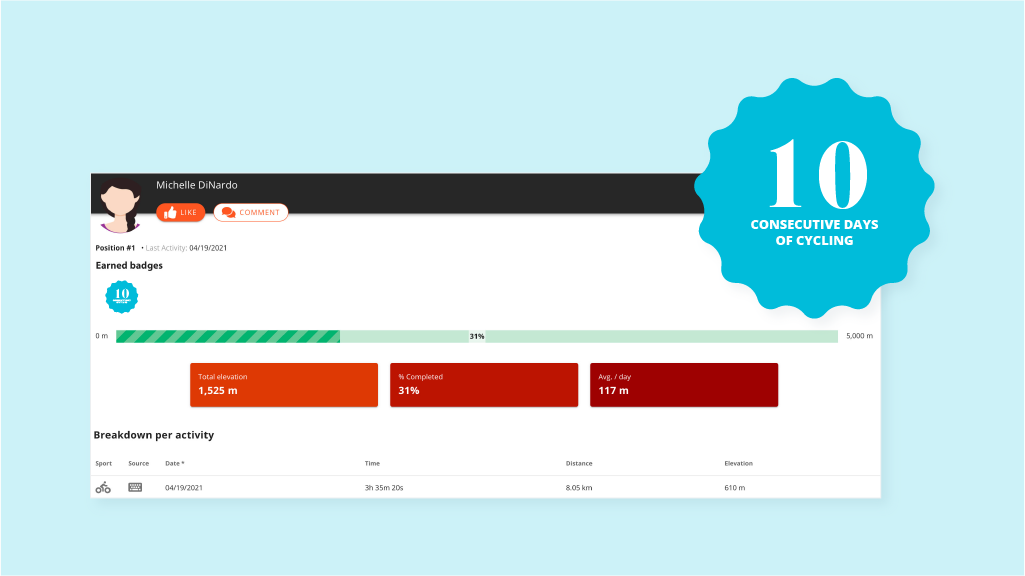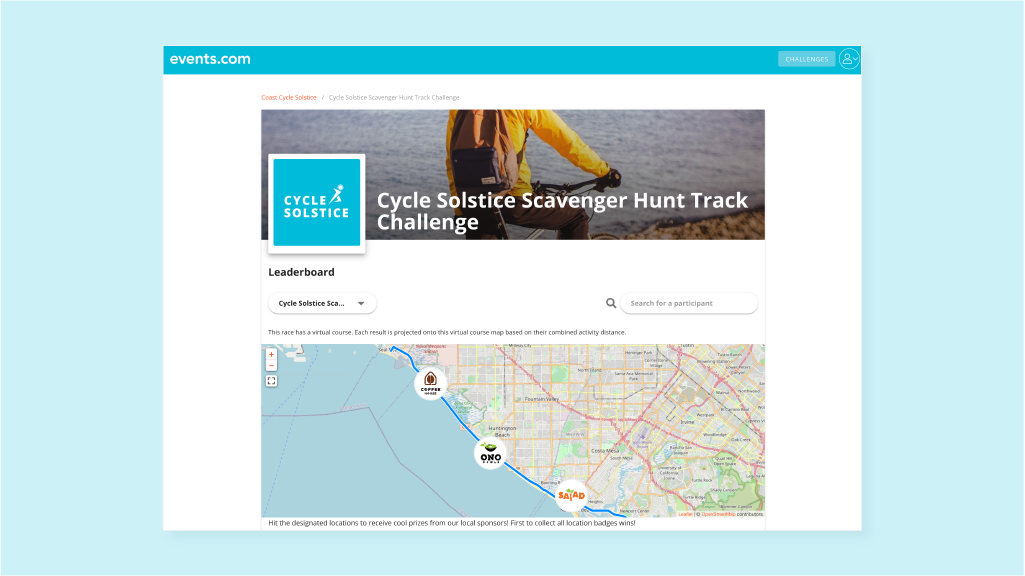It’s been some time since the world assumed that any event could only take place in person. Innovation has been essential throughout the event industry. Even traditionally in-person-only events like races and competitions have found ways to move online through virtual challenges but it’s not easy to come up with virtual challenge ideas.Â
These virtual challenges offer a new opportunity to stay relevant, grow events, connect with your audience, increase engagement, and generate new revenue. As things open back up, these virtual challenges are likely here to stay.
People who could not attend running events in the past can now take part wherever they are and whenever they’re free. Whether you’re eager to return to normal or not, a solid virtual challenge could be just what you need to get your event business back up off the ground.
To help get your creative juices flowing, we’ve put together some of our best ideas. Here are seven ways you may not have considered hosting an engaging virtual challenge your participants will love.
1. Host a Training Challenge
Training is an essential part of the race experience. Participants who want to do their best will train for weeks or months before an event to get into condition. If you’ve got some time before your next event, you can kill two birds with one stone by helping your audience help themselves.
Consider hosting a running event to help participants train for your next, bigger race. Whether you choose to set a specific training regime or allow each competitor to move at their own pace, plenty of people will jump at the chance to train with and against others.
You can also take steps to keep your audience engaged with a few simple tools. For example, you can display each person’s challenge progress on a leaderboard. From there, everyone involved can see and compare their training progress with one another. You can even provide teams so people can work together to train against other groups of friends.
Seeing their rankings can encourage each racer to improve their time. Meanwhile, people can message, motivate, and inspire each other to reach training goals. The result is a stronger community, motivated racers, and an audience dedicated to your platform, even between major races and events.

2. Design Exclusive Progress Badges and Medals
For many people with a competitive spirit, half the point of racing is to collect achievements and bragging rights. With the right tools, your virtual run events can offer more bragging opportunities than ever before.
One great way to offer participants proof of their accomplishments is to give them virtual badges they can display. Creating customized badges gives your audience something to strive for. If you make each badge unique to a specific challenge, you can also provide them with an incentive to participate in multiple virtual races over time.
Badges can be given out for all sorts of goals. Just a few potential badge opportunities include:
- Complete distances
- ‌Elevations climbed
- ‌Locations visited
- ‌Times achieved
When challenge contestants know that there’s a prize at the end of the virtual finish line, they’re more likely to stay engaged. After all, everyone likes acknowledgment—and getting a rare badge is an excellent way to reward people for their effort.
Make sure your racers know when they’ve unlocked a badge. Enable and customize email messages to be sent whenever you award someone a badge. Getting the notification on their phone and seeing congratulations in their inbox is a powerful motivator to keep people coming back for more.
3. Create a Total Time Challenge for Participants to Choose Their Favorite Activities
Not every racer has the same talent or ability. A brand new runner doesn’t have the cardio or condition to achieve the same times as a seasoned marathon runner, and that’s okay. Some people don’t even like running and prefer to do other activities. There’s no need for any of these people to be left out of your challenges, though.
You can reach out to people of all athletic types and abilities if you emphasize participation, not performance. You can do just that by making your next virtual or hybrid event a Time Challenge.
Instead of tracking someone’s mileage or speed, this type of competition tracks based on the amount of time people record doing their qualifying activities. Whoever spends the most time overall will rank highest, as opposed to the person who is simply the most talented.
This does two things. First, you can create a more even playing field for people who are just starting to become active, which opens your events up to more participants. Second, you can set many more qualifying activities, like:
- Cycling
- Pilates
- Running
- Swimming
- Walking the dog
- Yoga
- and more..
Each active minute will count equally towards the challenge goal. Exercise enthusiasts of every type will be able to participate.
4. Send Your Participants on a Virtual Treasure Hunt
Do you have a focus on a local area? Perhaps your brand encourages spending time outdoors, too. Either way, a virtual treasure hunt could be just the thing to both get people moving and give them a fun activity specific to your platform.
Virtual treasure hunts use location-based badges to encourage participants to explore around their city. These locations can be set up along running routes or scattered to incentivize multiple runs in different areas. You can set up each treasure hunt by themes, such as local restaurants, coffee shops, parks, museums, or even historical locations. Your audience gets to learn more about their city while you draw in people who want to mix up their regular routine.
You can structure these scavenger hunts in two ways. You can simply publish the locations on the list, so people can plan how they’ll visit the whole list. On the other hand, if you want to give the event an air of mystery, you can just publish hints and clues to the places people need to stop. The first method is excellent for short-term events, while the second can stretch out over weeks or months as a long-term quest.
5. Gamify Social Distancing
Social distancing is not particularly fun on its own. Many people feel stressed and lonely after the past months of keeping their distance from friends and strangers alike. Finding a way to show social distancing as not only the right choice—but also fun—is a great way to reward your audience for responsible behavior.
Try making a game out of social distancing for your participants. Set up a competition where people score more points for their run if they avoid other people and maintain social distancing in the process. They can do that by running off-peak hours when running routes are empty or going to less-busy paths and trails outside the city. Either way, this strategy keeps people safer and healthier while still getting their exercise with your platform.
You can also set up badges unrelated to a larger challenge that still reward runners for taking precautions. Offer unique badges for visiting less-common routes and parks one, five, and twenty times. While doing the right thing should be its own reward, it never hurts to give people a little more encouragement.
6. Create a Themed Challenge with a Creative Course Map
People enjoy feeling like they’re a part of something special. Whether that’s taking part in a charity challenge or simply taking part in a themed competition, it’s more engaging than joining a challenge to run a certain number of miles in a week.
Take advantage of this by creating challenges with creative themes. This gives your audience something interesting and it encourages joining the challenge in the first place. Plus, themed virtual and hybrid events don’t have the restriction of setting up a complete, blocked-off race route. You can get creative with everything from the achievements and badges to the map itself.
One great way to do just that is to set predetermined routes that spell out a word or create a shape. Holidays like Valentine’s Day or St. Patrick’s Day lend themselves to shapes like hearts and shamrocks. Similarly, HalSports challenged their participants to run a course map that spelled out HOPE across the city.
Themed challenges like these help your participants feel like they’re a part of something bigger. In a time when racing together isn’t safe, it’s comforting to know everyone is at least still running the same route. If that route itself is fun or inspiring, even better.
7. Offer New Real Estate to Your Sponsors
Beyond their ability to increase audience engagement, virtual challenges are a great opportunity to connect with sponsors. With a bit of creativity, you can give sponsors more real estate than ever before. Both new and past sponsors alike can benefit from the simple and convenient placements that virtual run events provide.
There are as many opportunities for sponsors in virtual events as there are during in-person events. Below are some ideas for your next virtual challenge.
Challenge Level Ownership
A common strategy for many challenges is to allow people to “level up” over time. You can offer sponsors the chance to own and support different levels in each challenge. This can include naming the level something like “[Sponsor]’s Level Three,” branding the email messaging that announces the level-up, and referencing the sponsor in challenges for that level.
Fully Branded Virtual Challenge Platform
For your biggest sponsors, you can set up a completely branded virtual challenge platform. Essentially, you can set up a custom, white-label version of your offering. This is an excellent option for longer, more meaningful relationships.
You can set up a custom URL, include the sponsor’s name in the title, thank them for their support, and reference their brand in the colors, artwork, and layout of the site.
Branded Series of Challenges
If you want to set up a long-term relationship, try a branded series of challenges. This can be a season- or year-long series of events, like “[Sponsor]’s Summer Sprints.” Each event can include the sponsor’s name, along with the logo on the welcome page and their logo in all your shareable resources.
Branded Single Event or Challenge
If you want to begin a new relationship with a sponsor, you can start with a single challenge. Still, take advantage of opportunities like titling the challenge with their brand name and include their logo in your work. Once a sponsor has seen the benefits of sponsoring a single challenge, they’re more likely to agree to a more extensive series sponsorship in the future.
Branded Race
Like branded challenges, a branded virtual race running event can be a short but valuable introduction to larger sponsorships. Include sponsors in the name, the welcome page, your art, and the completion email at the end of the race.
Branded Badge
For smaller sponsors, you can set up branded badges.
Name the badge after your sponsor, include their logo and colors in the badge itself, and reference them in the triggered email. You can also set up location-based branded badged that trigger when someone is within a predefined radius of that sponsor’s location during a challenge or race. Best of all, it can trigger an email with a coupon or discount code.
Leaderboard Banner
If there’s one page your participants will visit often, it’s the leaderboard and shared results page. Offering sponsors the chance to place a banner at the top of your leaderboard to get their message to all your participants no matter what badges or races they complete.
Make Virtual Events Work for Your Business
If you want even more suggestions, the Events.com Sponsorship team can help you identify where you could place your particular sponsors and help connect you with new sponsors that align with your brand.
There’s no doubt that virtual events are here to stay. You can take advantage of the opportunity these unique, low-stress events offer today with the experts at Events.com. Start creating your event today! Got questions or want some expert guidance? We’re here to help! Contact us at hello@events.com.
Otherwise, are you ready to set up your virtual challenge? Check out our full guide for step-by-step instructions on how to create an engaging virtual challenge.












